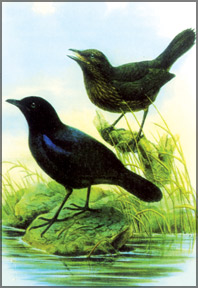Rare Lankan bird in danger of extinction
by K. G. H. Munidasa
The Sri Lanka Whistling Thrush or "Arrenga", a species endemic to the
island is categorised as a threatened bird in the World List of
Threatened Birds compiled by Birdlife International, United Kingdom.
This thrush was first described from the banks of Lemastota Oya 4,200
feet in the Haputale District in 1872 and named Mylophoneus blighi in
the Turdidae Family i.e. Robins, Chats and Thrushes (Annotated Checklist
Revised Edition 1978) classified as a species peculiar to Sri Lanka,
resident in the Hill Zone in the Central and Uva Provinces at elevations
of about 3,000 feet. It was named as Arrenga or Blighs Whistling Thrush
The popular Sinhala name given was "Sivuruhan Wal-avichchiya".
 |
|
Sri Lanka Whistling
Thrush |
W.E. Wait (1931) referring to Vincent Legge and other authorities has
earlier observed the Ceylon Arrenga as "one of our rarest residents and
confined to the hill country at elevations of over 2,000 ft. Later G. M.
Henry (Guide 1955) described the Arrenga as a mountain bird which does
not occur below about 3,000 feet and most likely to meet with between
the 4,000 and 6,000 feet contours." Strictly a forest-dweller, it loves
densely wooded ferny ravines and gorges, especially those that have a
rapid torrent running through them, for it is seldom seen far from a
stream. In such places in the evening, male flies about restlessly,
every now and then uttering its shrill, sibilant whistle Sree....ree,
which is much more often heard than its author seen."
The main breeding season is said to be in March and April, but a
second brood is often reared in August-September.
The nest is a large mass of green moss, mixed with twigs and dead
leaves, lined with fine rootlets, and generally placed on a ledge or in
the crevice of a rock beside a torrent or waterfall.
The Ceylon Bird Club has over the years has recorded in its monthly
notes Horton Plains, Nuwara Eliya (7,000 ft.), Maskeliya and the
Knuckles Range as the best places to visit to look for this elusive
bird.
Though I have been a active member of the Club since the early 1950s
and had joined in many a birding expedition along with such stalwarts in
the sphere like Ted Norris, Mc Leod Cameron.
I have had no opportunity at all to personally observe this most
secretive bird in the wilds, nor have I come across detailed accounts in
the club notes other than mere sight-records, over the ensuing years.
However, in April 1967, Roy Mc Leod Cameron then secretary of CBC put
on record a sight he had at Loolcandura Estate in Deltota, Hewaheta as
follos "I have had a good view of a female Arrenga or Whistling Thrush
this month. It settled on a rock in a stream in a deep jungle-clad
ravine. It was nearly midday and the sun shone on it, showing up various
shades of reddish-brown - a heavy-looking bird.
It did not stay long but fanned out its tail to one side and then
flew into thick cover. There are several streams on the estate, where I
can be pretty certain of hearing these birds at almost any time of the
day, but I very rarely see them, never a female before this.
I think that my birds must be abnormally shy as I have often sat
still and watched for them late into the dusk but have never had the
luck to see one actually `hopping about' (Henry's Guide p.34) for more
than a few moments."
|

